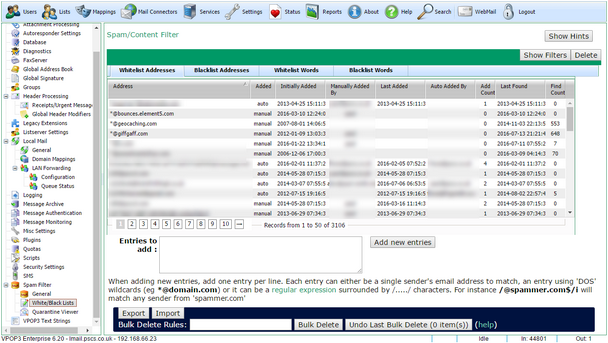
To get to this page, go to Settings → Spam Filter → White/Black Lists → Whitelist Addresses
The Spamfilter Whitelist Addresses list contains sender email addresses which you want to be allowed through the spam filter. VPOP3 checks the From, Reply-To and Return-Path addresses.
By default, whenever a local user sends a message to an external email address, the recipient is added to the whitelist. This can be disabled by setting the AutoWhiteList spamfilter setting to '0'.
The table shows the entries already in the whitelist.
•The Address column shows the email address.
•The Added column shows whether the address was manually added by someone typing it in, or opting to add it when releasing a message from the spamfilter quarantine, or automatically added when someone sent a message to that address.
•The Initially Added column shows when the address was initially added to the whitelist.
•The Manually added by column shows who manually added the address.
•The Last Added column shows when the address was last added (addresses may be automatically added multiple times, because they are added whenever someone sends a message to that address).
•The Auto Added by column shows the latest sender who caused the address to be automatically added.
•The Add Count column shows how many times the address has been automatically added.
•The Last Found column shows the latest time when the address was found as the sender of an incoming message.
•The Find Count column shows how many times the the address was found as the sender of an incoming message.
You can add new whitelist entries by typing them into the Entries to add box (one entry per line) and pressing the Add new entries button.
Note that when you add a new whitelist entry, VPOP3 will go through the quarantine and automatically release any already quarantined messages from that sender.
Also,note that, by default, VPOP3 will ignore whitelist entries for local senders. That is because these are not usually used as the senders for legitimate incoming email. You can change the CheckLocalWhitelist entry in the spamfilter script configuration to change this behaviour.
You can delete entries by selecting them and pressing the Delete button.
The Show Filters button will display boxes in the table headers where you can type search criteria. In the Add Count/Find Count filter boxes you can use numerical expressions, such as '<10' or '>100' etc.
Whitelist entries can be:
•complete email addresses which have to match totally
•wildcard email addresses (eg *@example.com or *.sales@example.net)
•regular expressions surrounded by / characters - eg /^[a-m]*@example\.(com|net)$/
The Export and Import buttons let you export or import the whitelist entries to a text file.
Bulk Delete Rules
The Bulk Delete Rules let you specify a rule to delete many whitelist entries at once.
The available rules are
1.auto - the entry was added automatically
2.manual - the entry was added manually
3.addcount <comparator> <number> - compare the addcount to the specified value.e.g. addcount>100
4.findcount <comparator> <number> - compare the findcount to the specified value. e.g. findcount<75
5.initiallyadded <comparator> <age> - compare the initially added date to the specified age. e.g. initiallyadded<5years
6.lastadded <comparator> <age> - compare the last added date to the specified age.e.g. lastadded>6months
7.lastfound <comparator> <age> - compare the last found date to the specified age. e.g. lastfound>=2days
8.addedby:<name> - compare the user which initially added the entry to the specified value (using wildcards). e.g. addedby:fred*
9.autoaddedby:<name> - compare the address which automatically added the entry to the specified value (using wildcards). e.g. autoaddedby:*@yahoo.com
10.matches:<regexp> - compare the entry address to the specified regular expression (case insensitive)
11.Any other value does a wildcard comparison of the value to the entry address
Do not put spaces around comparators, or after the colon character. Eg addedby:fred* is valid, addedby: fred* is not and will be treated as two separate conditions.
For ages, VPOP3 recognises the periods: minutes, hours, days, months, years (the 's' at the end is optional).
The comparators VPOP3 recognises are: <, =, >, <=, >=, <>
You should separate multiple conditions with space characters. All the specified conditions must match for the entry to be deleted. Once you have specified the conditions and pressed 'Delete', VPOP3 will tell you how many entries will be deleted, and will give you some examples of the entries which will be deleted. You can then confirm the deletion. If you find you have made a mistake, you can use the Undo Last Bulk Delete button to undo the latest bulk deletion (this only stores the deleted data for one day or until VPOP3 is restarted, whichever is the sooner).

